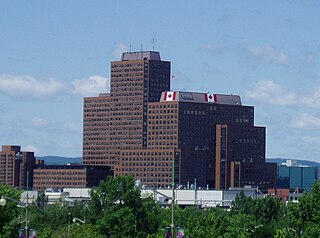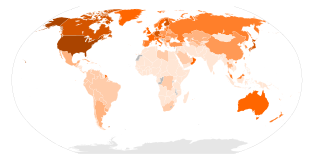Related Research Articles

The Canadian Radio-television and Telecommunications Commission is a public organization in Canada with mandate as a regulatory agency for broadcasting and telecommunications. It was created in 1976 when it took over responsibility for regulating telecommunication carriers. Prior to 1976, it was known as the Canadian Radio and Television Commission, which was established in 1968 by the Parliament of Canada to replace the Board of Broadcast Governors. Its headquarters is located in the Central Building of Les Terrasses de la Chaudière in Gatineau, Quebec.
A television broadcaster or television network is a telecommunications network for the distribution of television content, where a central operation provides programming to many television stations, pay television providers or, in the United States, multichannel video programming distributors. Until the mid-1980s, broadcast programming on television in most countries of the world was dominated by a small number of terrestrial networks. Many early television networks such as the BBC, CBS, CBC, NBC or ABC in the US and in Australia evolved from earlier radio networks.

The Canadian Broadcasting Corporation, branded as CBC/Radio-Canada, is the Canadian public broadcaster for both radio and television. It is a Crown corporation that serves as the national public broadcaster, with its English-language and French-language service units commonly known as CBC and Radio-Canada, respectively.

Broadcasting is the distribution of audio or video content to a dispersed audience via any electronic mass communications medium, but typically one using the electromagnetic spectrum, in a one-to-many model. Broadcasting began with AM radio, which came into popular use around 1920 with the spread of vacuum tube radio transmitters and receivers. Before this, most implementations of electronic communication were one-to-one, with the message intended for a single recipient. The term broadcasting evolved from its use as the agricultural method of sowing seeds in a field by casting them broadly about. It was later adopted for describing the widespread distribution of information by printed materials or by telegraph. Examples applying it to "one-to-many" radio transmissions of an individual station to multiple listeners appeared as early as 1898.
Public broadcasting involves radio, television, and other electronic media outlets whose primary mission is public service. Public broadcasters receive funding from diverse sources including license fees, individual contributions, public financing, and commercial financing, and avoid political interference or commercial influence.
The media of Canada is highly autonomous, uncensored, diverse, and very regionalized. Canada has a well-developed media sector, but its cultural output—particularly in English films, television shows, and magazines—is often overshadowed by imports from the United States. As a result, the preservation of a distinctly Canadian culture is supported by federal government programs, laws, and institutions such as the Canadian Broadcasting Corporation (CBC), the National Film Board of Canada (NFB), and the Canadian Radio-television and Telecommunications Commission (CRTC).
Public-access television is traditionally a form of non-commercial mass media where the general public can create content television programming which is narrowcast through cable television specialty channels. Public-access television was created in the United States between 1969 and 1971 by the Federal Communications Commission (FCC), under Chairman Dean Burch, based on pioneering work and advocacy of George Stoney, Red Burns, and Sidney Dean.

The American Federation of Television and Radio Artists (AFTRA) was a performers' union that represented a wide variety of talent, including actors in radio and television, radio and television announcers and newspersons, singers and recording artists, promo and voice-over announcers and other performers in commercials, stunt persons and specialty acts—as the organization itself publicly stated, "AFTRA's membership includes an array of talent". On March 30, 2012, the members of AFTRA and of the Screen Actors Guild (SAG) voted to merge and form SAG-AFTRA.

The Société de télédiffusion du Québec, branded as Télé-Québec, is a Canadian French-language public educational television network in the province of Quebec. It is a provincial Crown corporation owned by the Government of Quebec. The network's main studios and headquarters are located at the corner of de Lorimier Street and East René Lévesque Boulevard in Montreal.

A specialty channel can be a commercial broadcasting or non-commercial television channel which consists of television programming focused on a single genre, subject or targeted television market at a specific demographic.
West Virginia Public Broadcasting (WVPB) is the public television and radio state network serving the U.S. state of West Virginia. It is owned by the West Virginia Public Broadcasting Authority, an agency of the state government that holds the licenses for all Public Broadcasting Service (PBS) and National Public Radio (NPR) member stations licensed in West Virginia. It is headquartered in Charleston with studios in Morgantown and Beckley.
Television in Canada officially began with the sign-on of the nation's first television stations in Montreal and Toronto in 1952. As with most media in Canada, the television industry, and the television programming available in that country, are strongly influenced by media in the United States, perhaps to an extent not seen in any other major industrialized nation. As a result, the government institutes quotas for "Canadian content". Nonetheless, new content is often aimed at a broader North American audience, although the similarities may be less pronounced in the predominantly French-language province of Quebec.

Television in Israel refers to television broadcasting services in the State of Israel, inaugurated on March 24, 1966. Initially, there was one state-owned channel, operated jointly by the Israel Broadcasting Authority and the Israeli Educational Television. In 1986, a second state-regulated channel was launched. This channel became a state-regulated commercial channel in 1993. An additional commercial channel was introduced in 2002, followed by the introduction of three commercial niche channels: an Israeli Russian-speaking channel, a channel of Israeli popular music and an Arabic-speaking channel. Colour transmissions were introduced gradually around 1977 and 1979. Multichannel cable television service became available to subscribers gradually since 1989, although illegal cable TV stations were present in the big cities during the 1980s. Satellite-based multichannel service has been available since 2000.

The geographical usage of television varies around the world with a number of different transmission standards in use and differing approaches by government in relation to ownership and programme content.
Storer Broadcasting, Inc. was an American company which owned several television and radio stations in the Northeastern United States. It was incorporated in Ohio 1927, and was broken up in 1986.
WOSU-TV is a PBS member television station in Columbus, Ohio, United States. Owned by Ohio State University as part of WOSU Public Media, it is sister to public radio stations WOSU-FM (89.7) and WOSA. The three stations share studios on North Pearl Street near the OSU campus; WOSU-TV's transmitter is located on Highland Lakes Avenue in Westerville, Ohio.
Louisiana Public Broadcasting (LPB) is a state network of Public Broadcasting Service (PBS) member television stations serving the U.S. state of Louisiana. The stations are operated by the Louisiana Educational Television Authority, an agency created by the executive department of the Louisiana state government which holds the licenses for six of the seven PBS member stations licensed in the state. Louisiana Public Broadcasting's studio facilities and offices are located on Perkins Road in Baton Rouge.

The Public Broadcasting Act of 1967 issued the congressional corporate charter for the Corporation for Public Broadcasting (CPB), a private nonprofit corporation funded by taxpayers to disburse grants to public broadcasters in the United States, and eventually established the Public Broadcasting Service (PBS) and National Public Radio (NPR). The act was supported by many prominent Americans, including Fred Rogers, NPR founder and creator of All Things Considered Robert Conley, and Senator John O. Pastore of Rhode Island, then chairman of the Senate Subcommittee on Communications, during House and United States Senate hearings in 1967.

Connecticut Public Television (CPTV) is the PBS member network for the U.S. state of Connecticut. It is owned by Connecticut Public Broadcasting, a community-based non-profit organization that holds the licenses for all PBS member stations licensed in the state, and also owns the state's NPR member, Connecticut Public Radio (WNPR). Together, the television and radio stations make up the Connecticut Public Broadcasting Network (CPBN). CPBN is the state's only locally owned media organization producing TV, radio, print and Internet content for distribution across the state. As of 2019, Mark Contreras was announced as the new President / CEO. The organizational structure of CPTV also includes a Board of Trustees. The network co-produced the long-running children's television series, Barney & Friends until the show were transferred to WNET.
CTV 2 Alberta is a Canadian English language entertainment and former educational television channel in the province of Alberta. Owned by the Bell Media subsidiary of BCE Inc., it operates as a de facto owned-and-operated station of its secondary CTV 2 television system.
References
- ↑ Carmody, John (February 21, 1990). "The TV Column". Washington Post . Retrieved April 25, 2024.